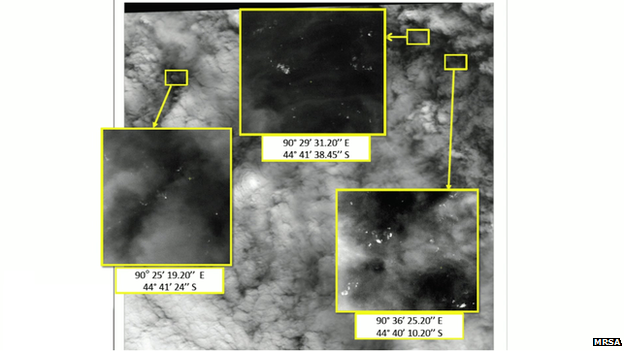Flight MH370: 122 new objects spotted - Malaysia minister
- Published

The images, given to the Malaysian Remote Sensing Agency by Airbus, show several light-coloured objects
A further 122 objects potentially from the missing Malaysian plane have been identified by satellite, the country's acting transport minister has said.
The images, taken on 23 March, showed objects up to 23m (75ft) in length, Hishammuddin Hussein said.
All aircraft taking part in Wednesday's search have now left the area without identifying debris from the plane.
Flight MH370 from Kuala Lumpur to Beijing disappeared on 8 March with 239 people on board.
Jon Donnison reports from Fremantle Port in Perth, where much of the search operation is based
The objects were found in satellite images from a 400 sq km area around 2,557km (1588 miles) from Perth in Western Australia, Mr Hishammuddin said.
He said that it was not possible to tell whether the potential objects were from the missing aircraft, but called them "another new lead that will help direct the search operation".
The images were supplied by French-based Airbus Defence and Space and were given to the Malaysian Remote Sensing Agency on 25 March, Mr Hishammuddin said.
The images were passed on to the Australian Rescue and Co-ordination Centre in Perth on Tuesday, he added.
The latest images are the fourth known collection of satellite pictures showing possible debris in the southern Indian Ocean. No pieces have yet been recovered in the search area, which has now been split into an east and west section.

The transport minister said Malaysia Airlines was "now taking a lead in communicating with the families" and would be conducting its own press conferences.
Aircraft leave area
The Australian Maritime Safety Authority (Amsa), co-ordinating the search, said that all aircraft involved had left the area without finding objects from the plane.
It said seven military and five civilian planes had taken part and a total of six countries were now involved - Australia, New Zealand, the US, Japan, China and the South Korea.
The commander of the Chinese search operation, Dong Yan, said his ships were still looking for an object spotted by a plane earlier on Wednesday.
"The focus is on searching for floating objects, oil slicks, floating parts of the external layer of the plane and people that may have fallen into the water," he told Chinese television.
Australian authorities said on Wednesday that three more objects had earlier been spotted by a civilian aircraft involved in the search.
However, it could not be confirmed whether they were related to the missing aircraft.
The search for debris from the missing plane is taking place in one of the world's remotest regions.
If debris confirmed to be from the plane is found, the search area will narrow further.
However, experts say the aircraft's locator beacons, which will help guide ships to the wreckage, now have less than two weeks of battery life remaining.
Specialised equipment which can help locate the beacon is being flown to the search area.
Hishammuddin Hussein: "This is another new lead that will help direct the search operation"
The area is known as "the Roaring Forties" due to its notoriously strong winds
Daniel Tan says he will "not give up hope" that his brother is alive until a wreckage is found